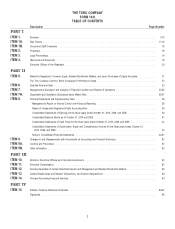Toro 2010 Annual Report Download - page 18
Download and view the complete annual report
Please find page 18 of the 2010 Toro annual report below. You can navigate through the pages in the report by either clicking on the pages listed below, or by using the keyword search tool below to find specific information within the annual report.construction; availability of credit to professional segment custom- could result in reduced sales of one or more of our residential
ers on acceptable terms to finance new product purchases; and segment products, resulting in increased inventory levels. Although
the amount of government spending for new grounds maintenance our residential lawn and garden products are generally manufac-
equipment. Among other things, any one or a combination of the tured throughout the year, our residential snow removal products
following factors could have an adverse effect on our professional are generally manufactured in the summer and fall months but
segment net sales: may be extended into the winter months depending upon demand.
•
reduced levels of investment in golf course renovations and Our production levels and inventory management goals are based
improvements and new golf course development; reduced num- on estimates of retail demand for our products, taking into account
ber of golf rounds played at public and private golf courses production capacity, timing of shipments, and field inventory levels.
resulting in reduced revenue for such golf courses; decreased If we overestimate or underestimate demand during a given sea-
membership at private golf courses resulting in reduced revenue son, we may not maintain the appropriate inventory levels, which
and, in certain cases, financial difficulties for such golf courses; could negatively impact our net sales, working capital, or hinder
and increased number of golf course closures, any one of which our ability to meet customer demand.
or any combination of which could result in a decrease in spend-
If we are unable to continue to enhance existing
ing and demand for our products;
products and develop and market new products that
•
reduced consumer and business spending, causing homeowners
respond to customer needs and preferences and
not to outsource lawn care and landscape contractor profession-
achieve market acceptance, we may experience a
als to forego or postpone purchases of our products;
decrease in demand for our products, and our net sales,
•
low or reduced levels of commercial and residential construction,
which have historically benefited from sales of new
resulting in a decrease in demand for our products; and
products, may be adversely affected.
•
reduced tax revenue, increased governmental expenses in other
areas, tighter government budgets and government deficits, gen- One of our growth strategies is to develop innovative, customer-
erally resulting in reduced government spending for grounds valued products to generate revenue growth. In the past, our sales
maintenance equipment; from new products, which we define as those introduced in the
current and previous two fiscal years, have represented a signifi-
Our residential segment net sales are dependent upon cant component of our net sales and are expected to continue to
The Home Depot, Inc. as a major customer, the amount represent a significant component of our future net sales. We may
of product placement at retailers, consumer confidence not be able to compete as effectively with our competitors, and
and spending levels, and changing buying patterns of ultimately satisfy the needs and preferences of our customers,
customers. unless we can continue to enhance existing products and develop
The elimination or reduction of shelf space assigned to our resi- new innovative products in the markets in which we compete.
dential products by retailers could adversely affect our residential Product development requires significant financial, technological,
segment net sales. Our residential segment net sales are also and other resources. Although we have implemented Lean manu-
dependent upon changing buying patterns of customers. For exam- facturing and other productivity improvement initiatives to provide
ple, there has been a trend away from consumer purchasing at investment funding for product enhancements and new products,
dealer outlets and hardware retailers to purchasing at home cen- we cannot be certain that we will be able to continue to do so in
ters and mass retailers, as well as a trend for broader and lower the future. Product improvements and new product introductions
price points at home centers and mass retailers. These trends also require significant planning, design, development, and testing
have resulted in an increased demand for residential segment at the technological, product, and manufacturing process levels
products purchased at retailers, such as The Home Depot, which and we may not be able to timely develop and introduce product
accounted for approximately 10 to 14 percent of our total consoli- improvements or new products. Our competitors’ new products
dated net sales in each of fiscal 2010, 2009, and 2008. We believe may beat our products to market, be more effective with more
that our diverse distribution channels and customer base should features and/or less expensive than our products, obtain better
reduce the long-term impact on us if we were to lose The Home market acceptance, or render our products obsolete. Any new
Depot or any other substantial customer. However, the loss of any products that we develop may not receive market acceptance or
substantial customer, a significant reduction in sales to The Home otherwise generate any meaningful net sales or profits for us rela-
Depot or other customers, or our inability to respond to future tive to our expectations based on, among other things, existing
changes in buying patterns of customers and new distribution and anticipated investments in manufacturing capacity and commit-
channels could have a material adverse impact on our business ments to fund advertising, marketing, promotional programs, and
and operating results. Changing buying patterns of customers also research and development.
12
























